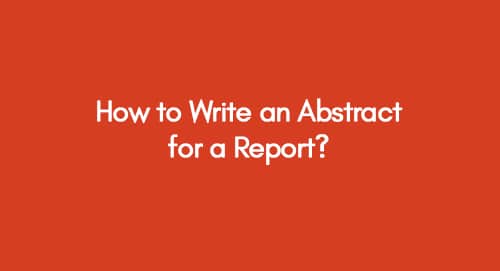
How to Write an Abstract for a Report: A Guide to Crafting Effective Summaries
October 25, 2022
How to Craft an Outline? | A Beginner’s Guide
October 26, 2022An abstract is like a movie teaser for your research paper. In addition to attracting readers, abstracts serve as helpful search tools for academics and researchers looking for articles relevant to their field of study.
Find Current Topics of Dissertations and Thesis
Explore Amazing Examples of Dissertation and Thesis Works
The following guidelines will help in understanding how to write an abstract for a research paper professionally.
What is an Abstract?
An abstract is a summary of a research paper. Its purpose is to inform readers about the argument your paper sets forth or the conclusion of your research. An abstract must stand on its own and not refer to any other part of the paper, such as a figure or table. In just 200-300 words, an abstract briefly describes what the reader can expect to find in your paper.
Elements to Include in an Abstract
An abstract should typically include the following key elements:
1- Purpose and Objectives
Clearly state the main purpose of the research or the problem being addressed. Identify the specific objectives or research questions that the study aims to answer.
2- Methodology
Provide a brief overview of the research design, methodology, and data collection techniques employed. Mention any specific methods or approaches used to conduct the study.
3- Results or Findings
Summarize the key findings, outcomes, or results of the research. Highlight the most important or significant findings that directly address the research objectives or questions.
4- Conclusion
Present the main conclusions or implications drawn from the findings. Briefly discuss the significance or impact of the research and its contribution to the field.
5- Scope and Limitations
Briefly mention any limitations or constraints of the study. This could include sample size, data limitations, or any other factors that may affect the generalizability or interpretation of the findings.
6- Keywords
Include a few relevant keywords or phrases that reflect the main topics or themes explored in the research. These keywords help index and categorize the paper for easier retrieval and searchability.
Learn an Interesting Way to Write Abstracts for Report Writing
It is important to note that an abstract's length and specific elements may vary depending on the target journal's requirements or publication. Some journals may also have specific guidelines for abstract structure, such as subheadings or section divisions. Therefore, it is advisable to carefully review the submission guidelines of the target journal to ensure compliance.
Types of Abstracts
There are generally four main types of abstracts: descriptive abstracts, informative abstracts, structured abstracts, and graphical abstracts. Let's explore each type in detail:
1- Descriptive Abstracts
Descriptive abstracts provide a brief overview of the research paper without revealing specific details about the study's findings, conclusions, or methodology. They typically summarize the research's main topic, scope, and purpose. Descriptive abstracts are commonly used in conference abstracts or when the full paper is not yet available, giving readers a general idea of the study's focus.
2- Informative Abstracts
Informative abstracts go beyond the descriptive elements and provide a more detailed research paper summary. They include essential information about the study's purpose, methodology, results, and conclusions. Informative abstracts give readers a more comprehensive understanding of the research and can help them decide whether to read the full paper. These types of abstracts are commonly used in academic journals.
3- Structured Abstracts
Structured abstracts follow a specific format or template that includes distinct sections. These sections often include background/objective, methods, results, and conclusion. By organizing the abstract in this structured manner, readers can quickly locate the information they are interested in. Structured abstracts are commonly used in scientific and medical research papers.
4- Graphical Abstracts
Graphical abstracts visually represent the research paper's key findings and main points. They typically include graphs, diagrams, images, or other visual elements to summarize the research visually. Graphical abstracts are becoming increasingly popular in scientific publications as they can quickly capture the attention of readers and convey complex information in a visually appealing way.
Explore a Step-by-Step Guide to Writing a Stellar Abstract
Explore Our Extraordinary Services for Your Benefit
It's important to note that the specific requirements and preferred types of abstracts may vary depending on the discipline, journal, or conference. Therefore, it is essential to carefully review the guidelines provided by the target publication to determine the appropriate type of abstract to use and to ensure compliance with their requirements.
Other Essential Elements
1. Format
The format of an abstract is subject to the specific guidelines set forth by the target journal or conference. Therefore, adhering to the provided instructions is crucial when preparing your abstract meticulously. Pay close attention to the journal or conference outlines' required length, structure, and content expectations. Following these guidelines ensures that your abstract aligns with the publication's standards and increases the likelihood of successful submission. By carefully adhering to the prescribed format, you demonstrate professionalism, attention to detail, and respect for the publication's requirements, enhancing the chances of your research being considered for publication or presentation.
2. Concerns about Ethics
If your research involves experimentation on living creatures, it is important to acknowledge the ethical concerns associated with such practices. In this section, you can address any potential worries or ethical considerations by discussing the steps taken to ensure the welfare and humane treatment of the subjects. Providing assurances regarding compliance with ethical guidelines, obtaining necessary approvals from relevant authorities or ethics committees, and implementing measures to minimize harm or distress to the animals can help address these concerns and demonstrate your commitment to responsible research practices.
3. Consequences
Including contradictory or challenging findings in the abstract can be beneficial, particularly when your study presents new information that contradicts or challenges a widely held theory or view. By highlighting these contrasting results in the abstract, you immediately capture the attention of readers and create an opportunity to present your unique perspective. This approach can generate interest and intrigue, encouraging readers to delve deeper into your research to understand your findings' implications and potential impact. Additionally, it showcases the originality and significance of your study, positioning it as a valuable contribution to the field by offering new insights and potentially reshaping existing knowledge or understanding.
Explore a Step-by-Step Guide on How to Write an Outline Here
Conclusion
Writing an abstract can seem tough sometimes, but it doesn't have to be! By following these simple steps on how to write an abstract for a research paper—you can make the process easy and painless. So don't delay; start writing that perfect research paper today!
Explore more on how to write an abstract
- How to Write an Abstract for a Report?
- A Step-By-Step Guide on How to Write a Stellar Abstract for Your Thesis
- How to Write A Good Abstract
Contact Premier Dissertations to help craft the perfect abstract for your next academic paper.
Get 3+ Free Dissertation Topics within 24 hours?




























